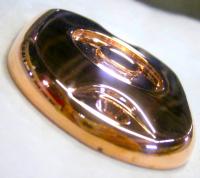
Photo from wikipedia
Exotic type deposits include several species of minerals, such as atacamite, chrysocolla, copper pitch, and copper wad. Among these, copper pitch and copper wad have considerable concentrations of manganese. However,… Click to show full abstract
Exotic type deposits include several species of minerals, such as atacamite, chrysocolla, copper pitch, and copper wad. Among these, copper pitch and copper wad have considerable concentrations of manganese. However, their non-crystalline and amorphous structure makes it challenging to recover the elements of interest (like Cu or Mn) by conventional hydrometallurgical methods. For this reason, black copper ores are generally not incorporated into the extraction circuits or left unprocessed, whether in stock, leach pads, or waste. Therefore, to dilute MnO2, the use of reducing agents is essential. In the present research, agitated leaching was performed to dissolve Mn of black copper in an acidic medium, comparing the use of ferrous ions and tailings as reducing agents. Two samples of black copper were studied, of high and low grade of Mn, respectively, the latter with a high content of clays. The effect on the reducing agent/black copper ratio and the concentration of sulfuric acid in the system were evaluated. Better results in removing Mn were achieved using the highest-grade black copper sample when working with ferrous ions at a ratio of Fe2+/black copper of 2/1 and 1 mol/L of sulfuric acid. Besides, the low-grade sample induced a significant consumption of H2SO4 due to the high presence of gangue and clays.
Journal Title: Metals
Year Published: 2019
Link to full text (if available)
Share on Social Media: Sign Up to like & get
recommendations!